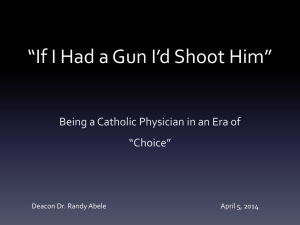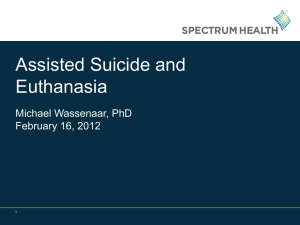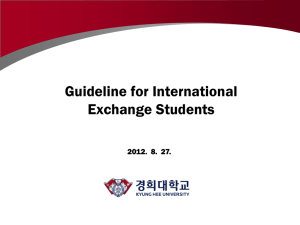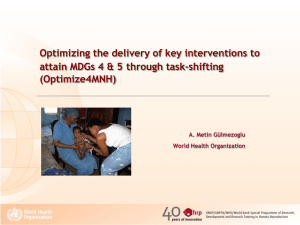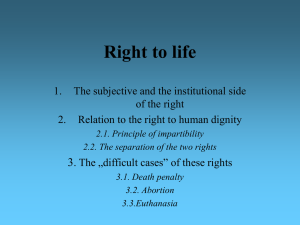The Right to Die with Dignity
advertisement
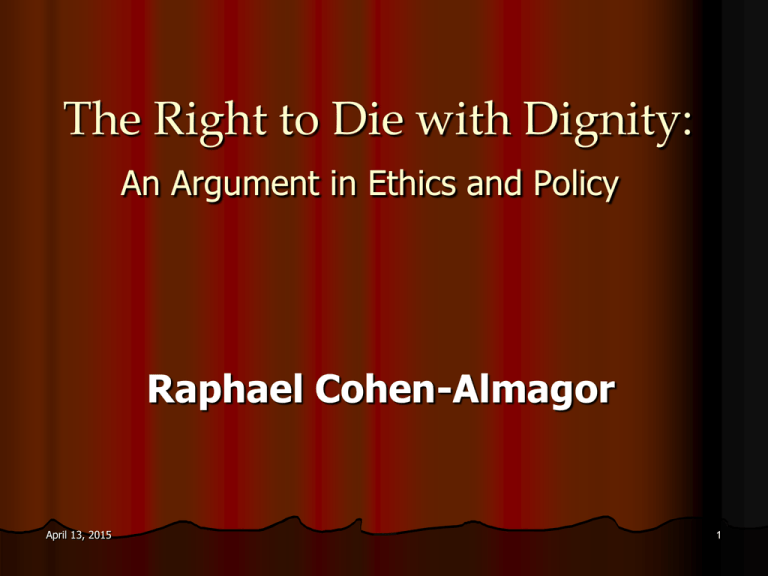
The Right to Die with Dignity: An Argument in Ethics and Policy Raphael Cohen-Almagor April 13, 2015 1 The Dilemma A person suffers a great pain and wants to die. Those who believe that life is intrinsically valuable object to taking action on the person’s desire. But their objection ignores the autonomy of the agent concerned. Can life be intrinsically valuable independently of the interests of the individual? Do these persons (or the state) have the right to impose their will over the will of the individual? April 13, 2015 2 Key concepts Liberty Autonomy Dignity Respect Concern Suffering Quality of Life Physician’s Role April 13, 2015 3 Key concepts Ethics v. Policy Making Fear of Abuse Control Mechanisms April 13, 2015 4 Liberty Liberty is required in order to enable people to discover, from the open confrontation of the ideas that are cherished in their society, their own views, their beliefs, and their future life plans. April 13, 2015 5 Liberty Liberty enables autonomy, self-rule, and self-direction. Accordingly, the view is that individuals should be left to govern their affairs without being overwhelmingly subject to external forces. Patients should be at liberty to end their lives if they so choose. April 13, 2015 6 Autonomy The central idea of autonomy is of selfrule, or self-direction. People are autonomous when they see themselves as sovereign in deciding what to believe in and in weighing competing reasons for action. April 13, 2015 7 Dignity To have dignity means to look at oneself with self-respect, with some sort of satisfaction. Timing of death: people should be allowed, whenever possible, to choose the time of their departure; and the way people die: with the help of medical professionals, people should be able to control the process of dying, maintaining autonomy at the end of life, not being humiliated, and perceiving themselves with honor. April 13, 2015 8 Dignity Life qua life is not that important but rather what one does with one’s life. Life in earnest is important, not just the mechanical processes that define life in the superficial meaning of the term. That one’s heart is beating and that one is able to breath are not sufficient reasons to maintain life. April 13, 2015 9 Dignity We must strive to reconcile the duty of keeping a person alive with her right to keep her dignity, which may also be considered as an intrinsic value. April 13, 2015 10 Respect for Others The objection to the ‘sanctity of life’ model is accompanied by support for the Respect for Others Argument. This argument is derived from the Kantian deontological school that accords all people equal respect. Respect for a person means seeing the other as an end rather than as a means to something. April 13, 2015 11 Kant As Immanuel Kant explains, persons are not merely subjective ends, whose existence as an effect of our actions has a value for us, but such beings are objective ends, i.e., they exist as ends in themselves. Such an end, Kant maintains, “is one for which there can be substituted no other end to which such beings should serve merely as means, for otherwise nothing at all of absolute value would be found anywhere.” April 13, 2015 12 Rawls We should give equal consideration to the interests of others and should grant equal respect to the others’ life projects so long as these do not deliberately undermine the interests of others by interfering in a disrespectful manner. As John Rawls asserts, “the public culture of a democratic society” is committed to seeking forms of social cooperation that can be pursued on a basis of mutual respect between free and equal persons.” April 13, 2015 13 Concern This line of reasoning should be supplemented by our emphasis on the notion of concern. The notion of ‘concern’ signals the value of well-being: we ought to show equal concern for each individual’s good, to acknowledge that human beings are not only rational creators but also emotional creatures. April 13, 2015 14 Concern Treating people with concern means treating them with empathy, viewing people as human beings who may be furious and frustrated, who are capable of smiling and crying, of careful-decision making and of impulsive reactions. ‘Concern’ means giving equal weight to a person’s life and autonomy. Mind, body, communication. April 13, 2015 15 Suffering Subjective Life of suffering is not worth living Makes death attractive Palliative care April 13, 2015 16 Palliative Care Until 2000, palliative care was underdeveloped in both Belgium and the Netherlands. Palliation seemed to be opposed to euthanasia. Both countries preferred to develop the practice of euthanasia. April 13, 2015 17 ‘Quality of Life’ Positive connotations, for example, in rehabilitation, cosmetic treatments, psychiatry, and psychology ‘Quality of Life’ However, when dealing with end of life issues, ethicists who support euthanasia use the term ‘quality of life’ in a negative sense more often than in a positive one, meaning that they do not seek to improve the patient’s life but to end it. April 13, 2015 19 Quality of Life A subjective concept, meaning that one’s quality of life is determined by one’s personal life circumstances Physician’s Role To heal To reduce suffering To improve quality of life To help patients find meaning in life To kill? “Why us?” “Philosopher’s assisted suicide” April 13, 2015 21 Role of Physicians In both Belgium and the Netherlands, the physician is required to devote energies in the patient and her loved ones, to consult with other specialists, to spend time and better the communication between all people concerned. April 13, 2015 22 Ethics v. Policy Making Difference between morally principled views and policy-making Difference between case-by-case decisionmaking and creating a general framework April 13, 2015 23 Euthanasia v. PAS One way to address this issue of abuse is to advance physician-assisted suicide for all patients who are able to swallow oral medication. However, in Belgium and in the Netherlands there is a tradition of doctors administering lethal drugs. In addition, there is also the issue of taking responsibility. Physicians in both countries like to have control over the process. April 13, 2015 24 Euthanasia v. PAS Consequently, in Belgium and the Netherlands there are relatively few cases of PAS. I suggest putting this issue on public agenda, speaking openly as people in Belgium like and appreciate about the findings and the fear of abuse, and suggest PAS as an alternative to euthanasia. April 13, 2015 25 Reporting In both Belgium and the Netherlands, problems with reporting. Why? Importance of reporting April 13, 2015 26 Consultation In both countries, the physician practicing euthanasia is required to consult an independent colleague in regard to (a) the hopeless condition of the patient, and (b) the voluntariness of the request. In both Belgium and the Netherlands, the independency requirement has been compromised. April 13, 2015 27 Consultation Studies showed, unsurprisingly, that almost all consultants regarded the request of the patient to be well-considered and persistent, conceded that there were no further alternative treatment options, and agreed with the intention to perform euthanasia or assisted suicide. In general, the GPs did not need to change their views or plans following the consultation. My own study (1999) showed that the consultants often were not independent from the physician who was asking for their opinion. April 13, 2015 28 Consultation Since 2000, SCEN in the Netherlands. Since 2003, LEIFartsen in Belgium. In Belgium, there are no rules regarding who decides the identity of the consultant. The only rule is that the consultant needs to be independent. Probably doctors approach like-minded physicians. Unclear what happens if there is disagreement between doctors. This issue deserves attention and probing. April 13, 2015 29 Suggestions for Improvement Physician-assisted suicide, not euthanasia, to ensure better control that at least in the Netherlands is lacking. April 13, 2015 30 Guideline 1 The physician should not suggest assisted suicide to the patient. Instead, it is the patient who should have the option to ask for such assistance. April 13, 2015 31 Guideline 2 The request for physician-assisted suicide of an adult, competent patient who suffers from an intractable, incurable and irreversible disease must be voluntary. The decision is that of the patient who asks to die without pressure, because life appears to be the worst alternative in the current situation. The patient should state this wish repeatedly over a period of time. These requirements appear in the abolished Northern Territory law in Australia, the Oregon Death with Dignity Act, as well as in the Dutch and Belgian Guidelines. April 13, 2015 32 Guideline 3 At times, the patient’s decision might be influenced by severe pain. The role of palliative care can be crucial . The Belgian law as well as the Oregon Death with Dignity Act require the attending physician to inform the patient of all feasible alternatives, including comfort care, hospice care and pain control. April 13, 2015 33 Guideline 4 The patient must be informed of the situation and the prognosis for recovery or escalation of the disease, with the suffering that it may involve. There must be an exchange of information between doctors and patients. The Belgian law and the Oregon Death with Dignity Act require this. April 13, 2015 34 Guideline 5 It must be ensured that the patient’s decision is not a result of familial and environmental pressures. It is the task of social workers to examine patients’ motives and to see to what extent they are affected by various external pressures. April 13, 2015 35 Guideline 6 The decision-making process should include a second opinion in order to verify the diagnosis and minimize the chances of misdiagnosis, as well as to allow the discovery of other medical options. A specialist, who is not dependent on the first doctor, either professionally or otherwise, should provide the second opinion. April 13, 2015 36 Guideline 7 It is advisable for the identity of the consultant to be determined by a small committee of specialists (like the Dutch SCEN), who will review the requests for physician-assisted suicide. April 13, 2015 37 Guideline 8 Some time prior to the performance of physician-assisted suicide, a doctor and a psychiatrist are required to visit and examine the patient so as to verify that this is the genuine wish of a person of sound mind who is not being coerced or influenced by a third party. The conversation between the doctors and the patient should be held without the presence of family members in the room in order to avoid familial pressure. A date for the procedure is then agreed upon. April 13, 2015 38 Guideline 9 The patient can rescind at any time and in any manner. This provision was granted under the abolished Australian Northern Territory Act and under the Oregon Death with Dignity Act. The Belgian Euthanasia Law holds that patients can withdraw or adjust their euthanasia declaration at any time. April 13, 2015 39 Guideline 10 Physician-assisted suicide may be performed only by a doctor and in the presence of another doctor. The decision-making team should include at least two doctors and a lawyer, who will examine the legal aspects involved. Insisting on this protocol would serve as a safety valve against possible abuse. Perhaps a public representative should also be present during the entire procedure, including the decision-making process and the performance of the act. April 13, 2015 40 Guideline 11 Physician-assisted suicide may be conducted in one of three ways, all of them discussed openly and decided upon by the physician and the patient together: (1) oral medication; (2) self-administered, lethal intravenous infusion; (3) self-administered lethal injection. Oral medication may be difficult or impossible for many patients to ingest because of nausea or other side effects of their illnesses. In the event that oral medication is provided and the dying process is lingering on for long hours, the physician is allowed to administer a lethal injection. April 13, 2015 41 Guideline 12 Doctors may not demand a special fee for the performance of assisted suicide. The motive for physician-assisted suicide is humane, so there must be no financial incentive and no special payment that might cause commercialization and promotion of such procedures. April 13, 2015 42 Guideline 13 There must be extensive documentation in the patient’s medical file, including the following: diagnosis and prognosis of the disease by the attending and the consulting physicians; attempted treatments; the patient’s reasons for seeking physician-assisted suicide; the patient’s request in writing or documented on a video recording; documentation of conversations with the patient; the physician’s offer to the patient to rescind his or her request; documentation of discussions with the patient’s loved ones; and a psychological report confirming the patient’s condition. April 13, 2015 43 Guideline 14 Pharmacists should also be required to report all prescriptions for lethal medication, thus providing a further check on physicians’ reporting. This is not the case now in both countries. April 13, 2015 44 Guideline 15 • Doctors must not be coerced into taking actions that contradict their heart and conscience, or their understanding of their role. • This was provided under the Northern Territory Act. April 13, 2015 45 Guideline 16 The local medical association should establish a committee, whose role will be not only to investigate the underlying facts that were reported but also to investigate whether there are “mercy” cases that were not reported and/or that did not comply with the Guidelines. April 13, 2015 46 Guideline 17 Licensing sanctions will be taken to punish those health care professionals who violated the Guidelines, failed to consult or to file reports, engaged in involuntary euthanasia without the patient’s consent or with patients lacking proper decision-making capacity. Physicians who failed to comply with the above Guidelines will be charged and procedures to sanction them will be brought by the Disciplinary Tribunal of the Medical Association. Sanctions should be significant. April 13, 2015 47 Thank you April 13, 2015 48
